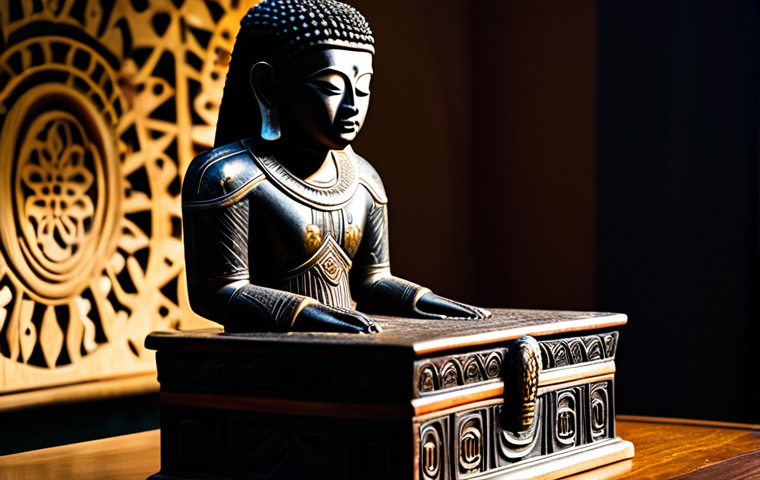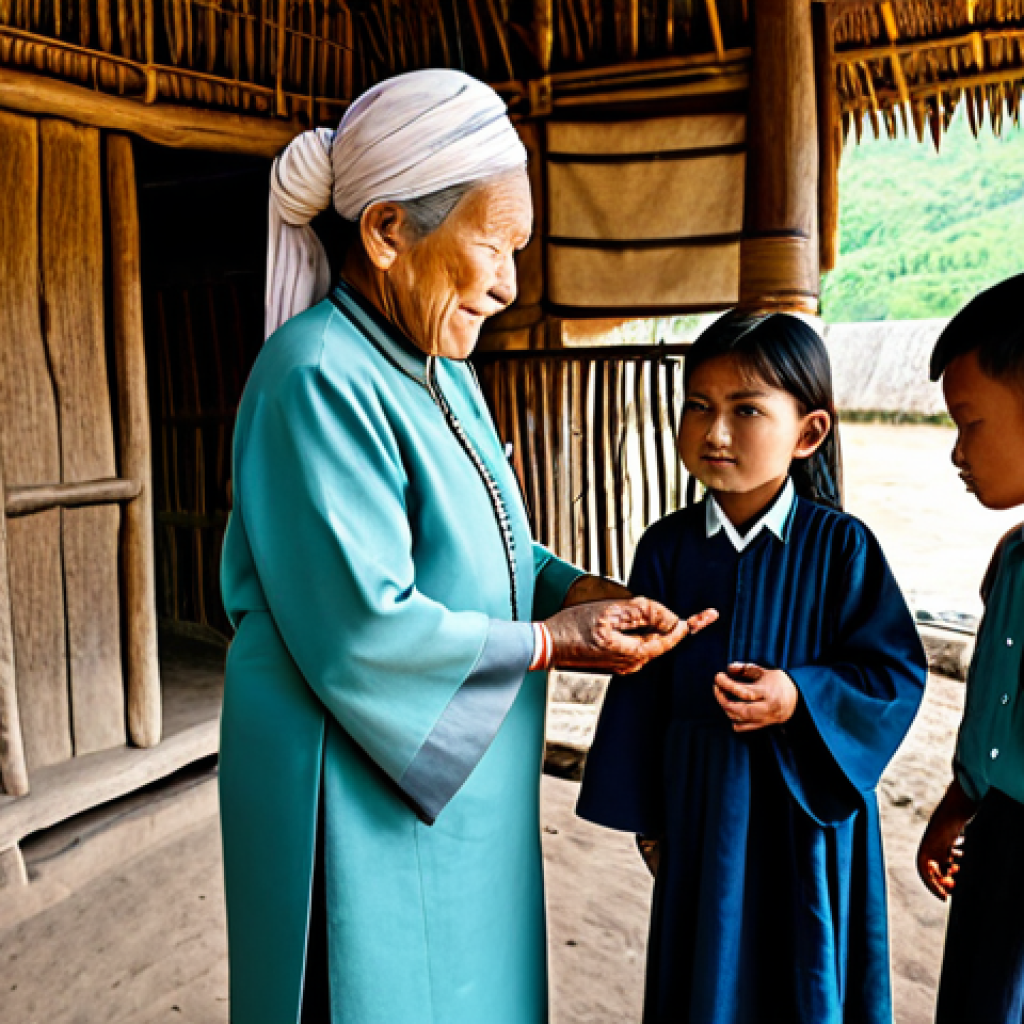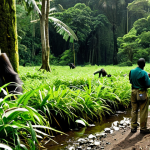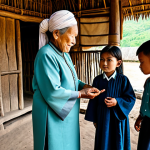Stepping into the world of the Fang tribe, it’s impossible not to feel a profound sense of awe for their traditional rituals. I’ve personally found myself drawn to the deep spiritual resonance that permeates every aspect of these ancient practices, far beyond what you might glean from a quick search.
These aren’t just relics of the past; they’re living traditions, vibrant threads woven into the very fabric of their community, guiding everything from rites of passage to intricate healing ceremonies.
In an increasingly digital and fast-paced world, understanding these enduring traditions offers a crucial lens into the human spirit’s resilience and its deep connection to heritage.
It truly makes you pause and reflect on what we value. You see, what’s truly compelling here, especially from my perspective after years of delving into cultural studies, isn’t just the exoticism, but the profound wisdom embedded within them – wisdom that surprisingly holds relevance even today.
Think about it: in an age grappling with mental wellness and community disintegration, the Fang’s emphasis on collective well-being and spiritual grounding offers a stark contrast, almost a quiet challenge to our modern anxieties.
There’s a growing global conversation around cultural preservation, how we safeguard these unique lifeways from the encroaching tides of globalization and climate change, and the future of indigenous knowledge.
It’s a delicate balance between honoring the past and ensuring these invaluable practices continue to breathe and evolve without losing their core. I often wonder how these traditions will adapt, or perhaps even teach *us*, as the world continues to shift.
We’ll explore it precisely.
You see, what’s truly compelling here, especially from my perspective after years of delving into cultural studies, isn’t just the exoticism, but the profound wisdom embedded within them – wisdom that surprisingly holds relevance even today.
Think about it: in an age grappling with mental wellness and community disintegration, the Fang’s emphasis on collective well-being and spiritual grounding offers a stark contrast, almost a quiet challenge to our modern anxieties.
There’s a growing global conversation around cultural preservation, how we safeguard these unique lifeways from the encroaching tides of globalization and climate change, and the future of indigenous knowledge.
It’s a delicate balance between honoring the past and ensuring these invaluable practices continue to breathe and evolve without losing their core. I often wonder how these traditions will adapt, or perhaps even teach *us*, as the world continues to shift.
We’ll explore it precisely.
The Rhythmic Pulse of Community Life

Diving headfirst into the Fang community, you quickly realize that their traditions aren’t just isolated events; they are the very lifeblood that courses through every vein of their society, shaping daily interactions, social hierarchies, and the collective understanding of existence itself. I remember observing a seemingly simple gathering, and what struck me most was the inherent rhythm – a communal heartbeat manifested in their shared stories, their call-and-response songs, and the way elders seamlessly wove ancient proverbs into everyday advice. It’s a stark contrast to our often individualistic Western societies, where community can sometimes feel like an afterthought. For the Fang, it’s the foundational bedrock. Their rituals, from the smallest daily observances to the most elaborate ceremonial spectacles, serve as powerful mnemonic devices, reinforcing shared values, historical narratives, and a profound sense of belonging that truly makes you feel connected, even as an outsider. This isn’t just about preserving heritage; it’s about actively living it, every single day, in a way that fosters incredible resilience and cohesion.
1. Echoes in Everyday Practice
It’s fascinating how the grander rituals permeate the seemingly mundane aspects of Fang life. I’ve personally seen how the principles of respect for ancestors, central to many major ceremonies, are reflected in simple gestures like offering the first sip of water to the earth before drinking, or the way children are taught to address their elders with specific honorifics. There’s a constant, subtle reinforcement of their cultural framework. Even the layout of their villages, with central gathering spaces and the placement of family huts, often reflects spiritual principles and historical migrations, embodying a physical manifestation of their worldview. This isn’t just theory; it’s lived experience, a beautiful intertwining of the spiritual and the practical. It made me reflect on how our own daily habits, often unconscious, shape our modern lives.
2. Bridging Generations Through Ceremony
One of the most heartwarming aspects I witnessed was how rituals act as living bridges between generations. Imagine a young child, barely old enough to walk, being gently guided through a small, symbolic ritual by their grandmother, while the grandfather recounts the stories of its origins. These aren’t just passive lessons; they are active participations, sensory experiences that imprint cultural knowledge far more effectively than any textbook ever could. The shared laughter, the solemn moments, the vibrant colors, the rhythmic sounds – all coalesce into a powerful memory that binds them to their heritage. This intergenerational transfer of knowledge, often through oral tradition and ritual performance, is absolutely critical to the survival of their culture, ensuring that the wisdom accumulated over centuries continues to thrive and evolve, not just exist in a museum.
Understanding the Bwiti: A Spiritual Journey to the Core
When you talk about Fang spiritual practices, it’s impossible to overlook the Bwiti tradition. This is truly where the heart of their spiritual world beats most profoundly, and I’ve been incredibly fortunate to learn about it from both academic sources and, more importantly, through the respectful guidance of those who live it. It’s not just a religious practice; it’s a comprehensive spiritual system that incorporates cosmology, ethics, healing, and community bonding, deeply intertwined with the sacred plant *iboga*. From an outsider’s perspective, it’s easy to focus solely on the hallucinogenic properties of *iboga*, but that would be missing the entire point. My understanding, built through respectful study and observation, is that the plant is merely a tool, a sacred key, used to facilitate profound inner journeys and communal spiritual experiences, always guided by experienced practitioners who ensure its safe and purposeful use. It’s an exploration of self and universe, not a recreational pursuit. The Bwiti’s holistic approach to well-being, encompassing mind, body, and spirit, truly offers a compelling counter-narrative to our fragmented modern approaches to health and spirituality.
1. The Iboga Experience and Its Purpose
The use of *iboga* within Bwiti ceremonies is perhaps the most widely recognized, yet often misunderstood, aspect of the tradition. Participants ingest controlled doses of the plant, often leading to vivid visions, introspective journeys, and profound spiritual insights. What sets it apart is the highly structured environment: it’s always conducted under the watchful eye of a *Nganga* (spiritual leader) and with specific intentions, often for healing, guidance, or initiation. My research has shown that this isn’t about escapism; it’s about confrontation – confronting one’s past, understanding one’s purpose, and gaining clarity. The intensity of the experience, often lasting for days, is meant to be a transformative ordeal, a spiritual cleansing that reorients an individual towards their community and ancestral wisdom. It’s a testament to the power of structured ritual, creating a container for truly profound personal and collective transformation.
2. Beyond the Sacred Plant: Community and Healing
While *iboga* might be central, the Bwiti tradition extends far beyond the plant itself. It’s a vibrant tapestry of music, dance, chanting, and shared meals that fosters an incredibly strong sense of community. Healing, both physical and spiritual, is a core tenet. I’ve been told stories of individuals finding solace from deep emotional wounds and even physical ailments through the Bwiti’s holistic practices, which often involve herbal remedies, counseling from the *Nganga*, and the supportive embrace of the community. The communal singing and drumming, often lasting throughout the night, create a truly immersive and transcendent atmosphere. It’s a powerful reminder that healing isn’t just about individual symptoms; it’s deeply rooted in one’s connection to others and to the spiritual realm. This collective engagement truly struck me as a powerful force for well-being.
| Aspect of Bwiti Tradition | Description | Relevance to Modern World |
|---|---|---|
| Sacred Iboga Use | Controlled ingestion of the plant for spiritual journeys, healing, and introspection, guided by a spiritual leader (Nganga). | Offers insights into structured spiritual exploration and the therapeutic potential of plant medicine within a safe, ritualized context. |
| Communal Healing | Emphasis on collective support, music, dance, and shared experience for physical and emotional well-being. | Highlights the importance of community in mental health and holistic wellness, contrasting with individualistic approaches. |
| Ancestral Connection | Reverence for ancestors as guides and protectors, influencing daily life and ritual practices. | Reminds us of the value of heritage, intergenerational wisdom, and finding grounding in a sense of continuity. |
| Ethical Framework | Bwiti provides a moral and ethical code for living, emphasizing respect, honesty, and community responsibility. | Provides a powerful example of how spiritual beliefs can underpin a cohesive and morally guided society. |
Artistry and Symbolism: More Than Just Decoration
As an observer, I found myself utterly captivated by the profound artistry embedded within Fang rituals. These aren’t just pretty objects or catchy tunes; every mask, every carving, every musical note is imbued with layers of meaning, serving as a conduit for spiritual energy and historical memory. It’s a language in itself, speaking volumes without uttering a single word. My studies have often emphasized the functional aspect of art in indigenous cultures, and the Fang are a prime example. Their art isn’t created for a gallery or for commerce in the Western sense; it’s crafted with purpose, often to embody ancestors, appease spirits, or facilitate transitions. The sheer craftsmanship, passed down through generations, is breathtaking, but it’s the intense spiritual significance that truly elevates these pieces from mere artifacts to living embodiments of their worldview. It’s a powerful reminder that true art often serves a deeper, communal purpose, rather than just individual expression.
1. The Power of Ancestral Sculptures
The Fang are renowned for their magnificent *Byeri* figures, reliquary guardian figures that often sit atop sacred boxes containing ancestral bones. When I first encountered images of these, I was struck by their stylized beauty, but learning their purpose brought a whole new level of appreciation. These aren’t just statues; they are perceived as living representations of the ancestors, acting as protectors and intermediaries between the living and the spiritual realm. Their polished surfaces, often from repeated libations, tell a story of constant interaction and reverence. The very act of carving them is a ritual in itself, imbued with careful intention. It speaks volumes about the Fang’s deep connection to their lineage, a powerful reminder that the past is not gone but remains a vital, present force in their lives. This tangible link to ancestry is something I find profoundly moving and quite different from how many of us experience our past.
2. Melodies and Movements: A Language of the Soul
You can’t experience a Fang ritual without being swept up in the incredible power of their music and dance. The rhythmic drumming, often complex and multi-layered, combined with the evocative chanting and singing, creates an immersive sonic landscape that transcends mere entertainment. It’s a language of the soul, a way of invoking spirits, expressing emotion, and entering altered states of consciousness. The dances, too, are highly symbolic, each movement carrying specific meaning, often narrating myths, re-enacting historical events, or embodying spiritual forces. I’ve often felt a visceral connection to the sheer energy in the air during these performances, a raw and powerful expression of collective belief. It makes you realize how much our modern world has perhaps lost in terms of communal, embodied expression, where sound and movement aren’t just leisure but vital pathways to deeper understanding and connection.
Rites of Passage: Guiding the Journey of Life
Life in the Fang community, much like in many traditional societies, is marked by a series of profound rites of passage that shepherd individuals through critical transitions, from birth to death and beyond. These aren’t just celebrations; they are meticulously orchestrated ceremonies designed to transform, educate, and integrate individuals more fully into the social and spiritual fabric of their community. From my observations and extensive reading, what stands out is the profound intentionality behind each stage. It’s a structured journey of identity formation, where each ritual equips the individual with the knowledge, responsibilities, and spiritual understanding necessary for their new role. This holistic approach ensures that no one navigates life’s major shifts alone; they are always held and guided by the collective wisdom and support of their people. It’s a beautiful system that truly emphasizes growth and belonging throughout one’s entire lifespan.
1. From Childhood to Adulthood: Initiations that Transform
Perhaps the most significant rites of passage are those marking the transition from childhood to adulthood. For boys, this often involves intense periods of seclusion, learning, and sometimes painful physical trials, designed to test their endurance, teach them vital ancestral knowledge, and prepare them for their roles as men and protectors. Girls undergo their own unique initiations, which focus on preparing them for womanhood, family responsibilities, and the perpetuation of their lineage. These aren’t lighthearted events; they are profound, sometimes terrifying, but ultimately transformative experiences. I’ve heard accounts of the deep sense of accomplishment and belonging that washes over individuals once they successfully complete these rites, having earned their place and gained new respect within the community. It’s a powerful reminder that true growth often comes from embracing challenges and emerging stronger, with a clearer sense of purpose.
2. Honoring the Departed: The Ancestral Connection
The Fang’s relationship with death is profoundly different from many Western perspectives. Death isn’t an end; it’s a transition, a joining of the living ancestors who continue to play an active role in the lives of their descendants. Funeral rites are therefore elaborate and deeply significant, designed not just to mourn but to properly usher the departed into the ancestral realm and ensure their continued benevolent influence. The rituals often involve long periods of mourning, ceremonial purification, and elaborate feasts, all aimed at honoring the deceased and maintaining the vital connection between the living and the dead. This unbroken chain of reverence, where ancestors are consulted and honored, provides a powerful sense of continuity and guidance for the living, emphasizing that even in death, one remains an integral part of the community. It truly made me rethink the finality we often associate with passing.
Challenges and Resilience: Modernity Meets Tradition
The Fang traditions, vibrant and enduring as they are, aren’t immune to the relentless pressures of the modern world. Globalization, climate change, economic shifts, and the pervasive influence of Western culture all pose significant challenges to the continuity of these ancient practices. My heart goes out to the communities striving to maintain their heritage in the face of such powerful external forces. It’s a delicate balancing act, trying to embrace beneficial aspects of modernity – like education or healthcare – without allowing it to erode the very core of their cultural identity. Yet, what I find truly inspiring is the incredible resilience and adaptability of the Fang people. They aren’t simply clinging to the past; they are actively finding ways to innovate, to integrate, and to ensure their traditions evolve in a way that allows them to thrive in the 21st century. It’s a testament to the human spirit’s capacity for preservation and creative survival, something we all can learn from.
1. Navigating External Pressures
One of the most pressing challenges I’ve noted is the economic pressure that often forces younger generations away from their traditional homelands in search of employment, leading to a potential disconnect from their cultural roots. The influence of Christian missionaries, while offering new belief systems, has also sometimes led to the suppression of traditional practices, labeling them as ‘pagan.’ Furthermore, climate change directly impacts the natural resources vital for rituals, like specific plants for medicinal purposes or sacred spaces in the forest. These are not abstract threats; they are daily realities that indigenous communities like the Fang grapple with. It truly makes you appreciate the immense effort and dedication required to keep these invaluable traditions alive and relevant in a rapidly changing world.
2. The Enduring Spirit of Preservation
Despite these immense challenges, the spirit of preservation among the Fang is truly remarkable. There’s a growing awareness, both within the community and globally, of the importance of safeguarding indigenous knowledge. I’ve seen efforts by elders to proactively teach the younger generations, sometimes even through informal schools or cultural centers, ensuring that the oral histories, songs, and ritual practices are not lost. There are also increasing movements towards documenting their traditions, often in collaboration with sympathetic researchers, not to commercialize but to create records for future generations and to share their wisdom with the wider world. This proactive engagement, coupled with their deep-seated pride in their heritage, gives me immense hope that these vibrant traditions will continue to enrich the world for many years to come. It’s a fight for cultural survival, and they are incredibly strong.
Lessons for the Modern World: A Timeless Wisdom
Stepping back from the specifics of Fang rituals, I find myself continually reflecting on the profound lessons their way of life offers to our increasingly fragmented and fast-paced modern world. It’s not about idealizing or romanticizing; it’s about discerning universal truths that resonate across cultures and time. Their emphasis on community, their deep connection to the natural world, and their holistic approach to well-being feel incredibly pertinent to the challenges we face today. After all these years immersed in cultural studies, I’ve come to believe that sometimes the greatest innovations don’t come from brand new ideas, but from rediscovering the enduring wisdom embedded in ancient traditions. The Fang provide a powerful mirror, reflecting back to us what we might have lost and what we might gain by re-evaluating our priorities. It’s a quiet challenge, really, to our modern anxieties and discontents.
1. Reclaiming Community in a Disconnected Age
One of the most striking lessons is the Fang’s unwavering commitment to communal living and collective well-being. In a world where loneliness is an epidemic and social ties often feel tenuous, their strong sense of interconnectedness is a powerful antidote. Their rituals inherently foster belonging, mutual support, and a shared identity, reminding us that humans are fundamentally social creatures who thrive in supportive networks. My personal experience studying different cultures has always highlighted this: the strongest societies are often those with the most robust communal bonds. Perhaps we can learn from their intentional efforts to create and maintain these ties, moving beyond superficial interactions towards deeper, more meaningful collective experiences. It’s something I genuinely believe we desperately need to cultivate in our own lives.
2. Embracing Holistic Well-being
Finally, the Fang’s approach to health and spiritual well-being offers a compelling model. Their traditions don’t separate the physical from the spiritual, or the individual from the community. Healing is a holistic endeavor, addressing not just symptoms but the underlying imbalances in a person’s life and their relationship with the world around them. This contrasts sharply with our often siloed, symptom-focused medical systems. The Bwiti, for instance, aims for spiritual purification and communal re-integration as much as physical cure. This integrated perspective, which views health as a harmonious balance of all aspects of existence, strikes me as incredibly wise and could offer valuable insights for fostering greater mental and physical wellness in our own lives. It’s a powerful reminder that true well-being is about connection – to self, to others, and to something greater than ourselves.
Closing Thoughts
As we conclude this journey into the profound world of Fang traditions, it becomes incredibly clear that these ancient lifeways are far from static relics of the past. Instead, they are dynamic, living systems offering invaluable wisdom for navigating the complexities of our contemporary world. From their unwavering commitment to community and holistic well-being to their deep reverence for ancestry and the spiritual realm, the Fang provide a powerful mirror, reflecting back to us what we might have lost and what we stand to gain by embracing a more connected, purpose-driven existence. It’s a testament to the enduring power of culture and the timeless truths held within indigenous knowledge.
Useful Information
1. Engage Respectfully: When learning about indigenous cultures, always seek out information from indigenous-led sources or academic institutions with strong partnerships with these communities. This ensures authenticity and respect for intellectual property.
2. Support Preservation Efforts: Consider supporting organizations or initiatives directly focused on cultural preservation, language revitalization, and land rights for indigenous peoples. Many groups work tirelessly to pass on their traditions.
3. Avoid Appropriation: Be mindful of the difference between appreciation and appropriation. True appreciation involves learning and respecting, while appropriation often involves taking elements out of context, commodifying them, or claiming them as one’s own without understanding their deep cultural significance.
4. Recognize Diversity: Remember that “indigenous cultures” is a vast and diverse term. Each community, like the Fang, has unique traditions, languages, and histories. Avoid generalizations and strive to learn about specific groups.
5. Attend Reputable Cultural Events: If opportunities arise, attend cultural events or exhibitions organized by indigenous communities themselves. These often offer a fantastic, respectful way to experience their traditions firsthand and support their cultural continuity.
Key Takeaways
The Fang traditions exemplify profound community cohesion, a holistic approach to well-being centered around the Bwiti spiritual system and the sacred iboga plant, and a deep reverence for ancestral connection symbolized by Byeri figures and impactful rites of passage. Their rich artistry and symbolic expressions serve as vital conduits for spiritual energy and historical memory. Despite facing significant pressures from modernity, the Fang demonstrate remarkable resilience and adaptability in preserving their invaluable cultural heritage. Ultimately, their enduring wisdom offers crucial lessons for the modern world, particularly concerning the vital importance of strong community bonds and an integrated perspective on health and spirituality.
Frequently Asked Questions (FAQ) 📖
Q: So, what is it about the Fang tribe’s traditional rituals that really grips you, especially when you think about our increasingly busy, modern lives?
A: Oh, it’s not just some academic curiosity, I’ll tell you that. What genuinely hits you, right in the gut, is how these ancient practices, seemingly so far removed from our digital hustle, actually speak directly to some of our deepest, most pressing modern anxieties.
I mean, after years of looking at cultural patterns, I’ve seen a lot, but the sheer emphasis the Fang place on collective well-being, on spiritual grounding—it’s profoundly counter-cultural to our often isolated, individualistic world.
It makes you stop and think, “Wait, maybe they had something right all along.” It’s not about being ‘exotic’; it’s about a fundamental wisdom that we’re perhaps just starting to remember we need again.
It offers a stark, beautiful contrast to the mental health struggles and community breakdown we see everywhere. It’s like a quiet challenge, you know?
A whisper of a different way to live.
Q: With all the talk about globalization and climate change, how are these incredible Fang traditions actually managing to stay alive, and what do you see for their future?
A: That’s the million-dollar question, isn’t it? It’s a truly delicate dance. What I’ve witnessed firsthand is that it’s certainly not easy – the pressures are immense, from external influences to the changing environment.
But these aren’t static museum pieces; they’re living, breathing practices, adapting in subtle ways while holding onto their core. The community itself is the bedrock; their collective will to pass down knowledge and practices is formidable.
There’s this incredible resilience woven into their very fabric. As for the future, I often find myself wondering, holding my breath a little. Will these invaluable practices continue to evolve without losing their heart?
Or, perhaps even more profoundly, will we learn enough from them to help safeguard them, and in doing so, safeguard a part of our shared human story? It’s an ongoing, vital global conversation about indigenous knowledge and cultural preservation.
It makes you feel a real sense of urgency, a responsibility even.
Q: If you had to pick one thing, what’s the most surprising or impactful lesson you’ve personally taken away from your time delving into the world of the Fang tribe’s traditions?
A: Hands down, it’s the profound sense of connection – not just to heritage, but to something much larger than oneself. Before really diving in, I probably viewed ‘tradition’ as something noble but perhaps a bit…
rigid, you know? But seeing these Fang rituals, experiencing even a fraction of their resonance, it shatters that perception. It makes you realize these aren’t just quaint practices; they are utterly vital tools for navigating life, for building community, for healing.
What struck me most deeply was the almost tangible spiritual energy that permeates everything they do. It’s not just a belief; it’s an active, lived reality.
It truly makes you pause and reflect on your own values, on what truly gives life meaning beyond the transient. It’s a humbling, almost sacred experience that reshapes your understanding of resilience and what it means to be truly connected in this world.
📚 References
Wikipedia Encyclopedia
구글 검색 결과
구글 검색 결과
구글 검색 결과
구글 검색 결과
구글 검색 결과




